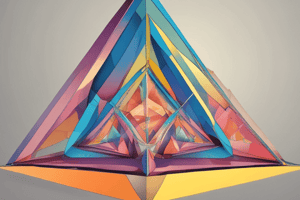Podcast
Questions and Answers
What is the defining characteristic of a prism?
What is the defining characteristic of a prism?
- Having two parallel, congruent bases connected by rectangular faces (correct)
- Having two identical bases connected by triangular faces
- Having all points equidistant from a center point
- Having a curved surface connecting two circular bases
Which of the following is NOT an example of a prism?
Which of the following is NOT an example of a prism?
- Cylindrical prism (correct)
- Triangular prism
- Pentagonal prism
- Rectangular prism
What is the defining characteristic of a sphere?
What is the defining characteristic of a sphere?
- Having a curved surface connecting two circular bases
- Having a base and a slanted lateral face
- Having all points equidistant from a center point (correct)
- Having two parallel, congruent bases connected by rectangular faces
Which of the following is a characteristic of a cylinder?
Which of the following is a characteristic of a cylinder?
What is the defining characteristic of a cone?
What is the defining characteristic of a cone?
What is the defining characteristic of a pyramid?
What is the defining characteristic of a pyramid?
Which of the following is a use of a cylinder?
Which of the following is a use of a cylinder?
What is the defining characteristic of a cone?
What is the defining characteristic of a cone?
Which of the following is NOT a common use of a pyramid?
Which of the following is NOT a common use of a pyramid?
What is the defining characteristic of a sphere?
What is the defining characteristic of a sphere?
Study Notes
Geometry: Prisms, Spheres, Cylinders, Cones, and Pyramids
Geometry is the branch of mathematics concerned with shapes and their properties. It involves the study of points, lines, surfaces, angles, curves, solids, and transformations. In geometry, we often deal with special types of objects called geometric figures. Let's explore some common geometric figures: prisms, spheres, cylinders, cones, and pyramids.
Prisms
A prism is a three-dimensional shape with two parallel congruent bases connected by rectangular faces parallel to the bases. A regular prism has two identical congruent bases of congruent triangles, squares, pentagons, hexagons, etc., where edges perpendicular to the base meet at right angles and the other edges (called sides) form congruent rectangles.
Examples of Prisms
There are several examples of prisms, including:
- Triangular prism: Two triangles as bases with congruent lateral faces.
- Rectangle prism: Two rectangles as bases.
- Pentagonal prism: Two different polygons as bases.
Spheres
A sphere is a three-dimensional object that has all points equidistant from its center. In other words, every point on a sphere lies a constant distance from the center point. Spheres can have various radii, depending on how far apart the points are from the center.
Cylinders
A cylinder is a three-dimensional figure with two parallel circular bases connected by a curved surface called a lateral face. One end of the cylinder is open, while the other may be open or closed.
Cones
A cone is a solid figure consisting of a circular base, any height above it, and a vertex above the base, which extends infinitely far into space. Each cross section of a cone parallel to the base is a circle.
Pyramids
Pyramids are three-dimensional figures with polygonal bases and triangular faces meeting at a point called the vertex. There are several types of pyramids, including triangular, rectangular, square, and pentagonal pyramids.
Studying That Suits You
Use AI to generate personalized quizzes and flashcards to suit your learning preferences.
Description
Explore the properties of common geometric figures like prisms, spheres, cylinders, cones, and pyramids in three-dimensional space. Learn about their shapes, bases, lateral faces, vertices, and more.





